No products in the cart.
Email Marketing
What It Is, How to Repair It, and FAQs
It can take so much work to get someone to notice your product. From building a website, growing an email list, creating paid ads, and more, getting someone interested in your product is an accomplishment.
And when a consumer puts a product into their online shopping cart, that’s a huge signal that they’re ready to purchase. At that point, the buying process is so close to the finish line. But unfortunately, a new battle begins here: the fight against shopping cart abandonment.
This article will explain shopping cart abandonment, why customers drop off, and how you can close more sales by optimizing the customer experience.
Table of contents
Shopping cart abandonment is when an online shopper places items into their digital cart but leaves the website without making a purchase.
For example, let’s say someone is shopping for bedroom furniture online. They spend 20 minutes browsing a website before deciding on a nightstand. They click “add to cart, ” signaling that they are interested in making a purchase and have picked out a particular product. Then, the shopper is distracted by a phone call and closes their laptop.
An interrupting phone call is simply a stroke of bad luck.
Then there’s the 58.6% of shopping cart abandoners who say they were “just browsing.” Some abandoned shopping carts aren’t within your control. However, there are many cases where the design of your shopping experience can prevent shoppers from completing their purchase (more on that shortly).
Grow your business and future-proof your career with our FREE marketing strategy template!
Why is shopping cart abandonment a problem for retailers?
To anyone who’s worked in a retail store and had to restock abandoned merchandise wherever customers decide to leave it, an abandoned digital shopping cart might not seem so bad. But every abandoned shopping cart is a lost sale.
For ecommerce and other online businesses, it’s especially frustrating because the customer is so close to completing the purchase. It’s like a football team getting stopped at the 5-yard line.
There are many reasons a shopper might abandon their cart, some of which are within the retailer’s control. Retailers can use data on shopping cart abandonment to improve the purchase process. Tracking and analyzing cart abandonment data can help you learn about the user experience you’ve created and what your customers value.
How to calculate your shopping cart abandonment rate
You can (and should) calculate your business’ shopping cart abandonment rate and monitor the metric regularly. This calculation is pretty simple: divide the number of incomplete transactions by the number of initiated transactions. In this case, a transaction is initiated when the user places something in their cart.
For example, if 100 people place at least 1 item in their cart and 34 shoppers complete their purchase, 66 people abandoned their shopping cart.
66 incomplete transactions / 100 initiated transactions = 0.66, or a 66% abandonment rate
That’s actually not a bad number.
The average shopping cart abandonment rate is almost 70%. And research suggests that abandonment is even higher among mobile users.
Cart Abandonment By Device
You can dig even deeper into cart abandonment by tracking at what stage in the buying process the user stops.
Sometimes, users simply get distracted and fail to complete their purchases. While a user’s environment is out of your control, the good news is there are many reasons people abandon their cart that retailers can impact.
Here we explain the top 5 reasons customers abandon their shopping carts. After that, we’ll discuss strategies to reduce abandonment.
High fees or shipping costs
When shoppers were asked in a survey why they abandoned a purchase during the checkout process, extra costs (taxes, shipping, fees, etc.) were the number 1 reason. There’s not much you can do about taxes, but the most common fee shoppers face is shipping.
Unfortunately, giant businesses like Amazon have trained customers to expect fast and free shipping. One survey found that 80% of shoppers expect free shipping above a certain dollar amount, and 66% expect free shipping on ALL orders.
Long or confusing checkout process
Among those surveyed, 17% cited a long or complicated checkout process as 1 of the reasons they abandoned their purchase. A checkout process is like any other digital experience: the more difficult it is to navigate and complete, the fewer people will succeed.
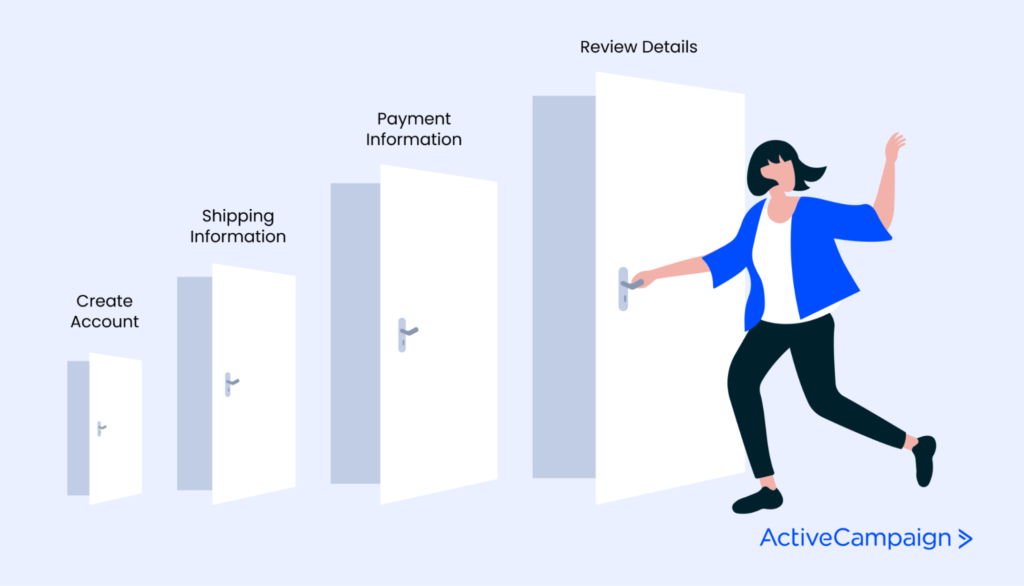 Stages of checkout with exit doors
Stages of checkout with exit doorsFor example, does the user need to complete separate pages for delivery address, delivery speed, payment information, and final review? With each additional page, you give the user 1 more opportunity to drop off.
Requires account creation
Much like a complex checkout process, forcing users to create an account is an additional step that some users find intrusive and inconvenient. Forced account creation was the second most-cited reason for cart abandonment.
Some retailers, like home improvement store Lowe’s, allow users to make purchases without an account.
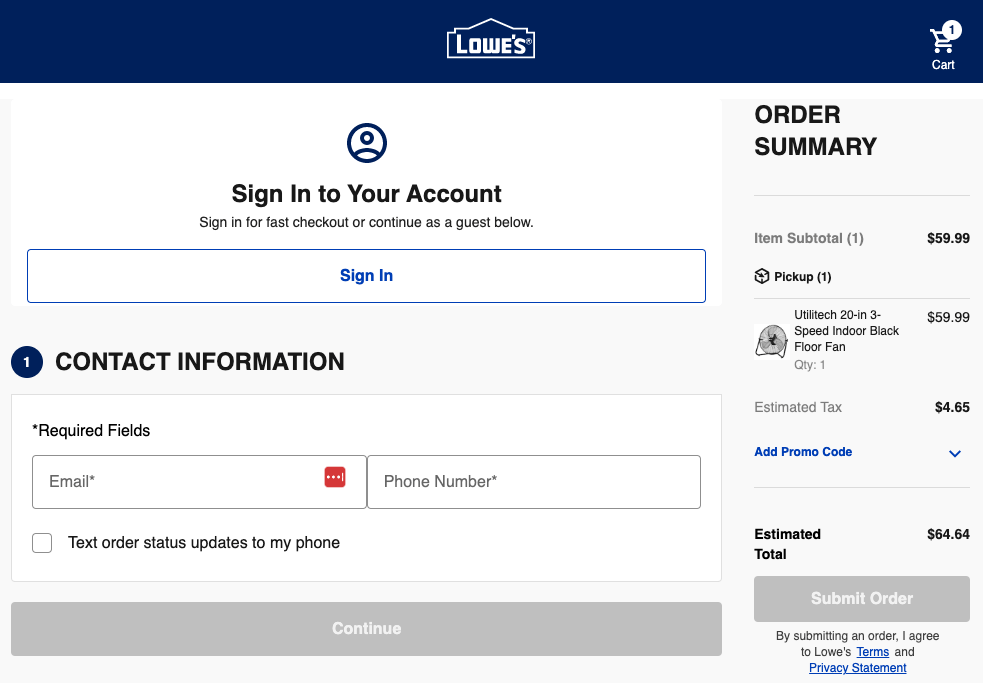 Lowe’s guest checkout page
Lowe’s guest checkout pageFor some retailers, asking customers to create an account makes sense. This can make it easier to close repeat business and even make targeted marketing easier. Businesses have to weigh these potential benefits against the number of users who would rather leave the site than create yet another online profile.
The account creation question may depend on the type of business or industry. It’s a good idea to check whether your competitors’ checkout processes require account creation. This will help you determine whether you should do the same.
Lack of trust
As common as online shopping has become, some potential customers remain cautious about which sites to trust with their information. If a potential customer doubts the security of their information, they may abandon the purchase or even look for a more trustworthy option.
This is a bigger issue for small businesses, which don’t have the longevity and brand recognition of larger competitors. Keep in mind that presenting a professional image and web experience also contributes to user trust. Spelling mistakes, display errors, or a website that often crashes could all convey to a potential customer that your business isn’t reliable or even legitimate.
Lack of payment options
Beyond trusting that their payment information is secure, customers often have preferences for their payment method, whether ACH, credit card, PayPal, or any other option. If they were already on the fence about completing their purchase, not offering their payment method could be the ultimate reason they abandoned their cart.
Now that we’ve identified the top reasons for shopping cart abandonment, we’ll walk through some strategies to reduce the abandonment rate.
Identify dropoff points
The most important step you can take to reduce the number of shopping cart abandonments is to figure out where in the process users are dropping off. There are more resources than ever for discovering these dropoff points, from Google Analytics to ecommerce platforms.
If, for example, people drop off on a page where the final total with shipping fees is displayed, those fees could be scaring customers off. On the other hand, if customers are proceeding to the payment method page but stopping there, your payment options could be an issue.
For a more detailed understanding of your customer’s journey, you can use a behavior monitoring tool, like UserTesting, or even conduct customer interviews.
Offer free shipping
As we mentioned, more and more consumers expect free shipping, particularly for orders above a certain dollar amount. The free shipping threshold will depend on your business, so study your average cart size to determine what amount makes sense. To offer free shipping, you may have to reevaluate your pricing as a whole.
Another route is to offer flat-rate shipping below a certain purchase level, like the pet supplies site Chewy.com has done. For orders under $49, Chewy.com charges a flat shipping rate of $5. They even add a progress bar to show the user how close to getting free shipping they are.
Even if the customer doesn’t reach the threshold for free shipping, having a transparent and consistent shipping cost can prevent sticker shock during the checkout process.
Optimize the checkout design and process
Speaking of the checkout process, optimizing it should be an ongoing mission for your business. By the time a potential customer reaches this stage, they’ve shown significant interest in making a purchase. The checkout process is your chance to seal the deal.
For repeat customers, setting up 1-click ordering could be a big win. After all, it can’t get much easier than that. Amazon first popularized this feature, but Shopify and other tools make it also possible for new or small businesses.
Even if 1-click checkout isn’t right for you, you can still condense the number of steps and web pages in the checkout process. Accordion-style checkout pages, such as those used by cosmetics brand Kiehl’s, allow businesses to collect delivery, shipping, and payment information on a single page without overwhelming users.
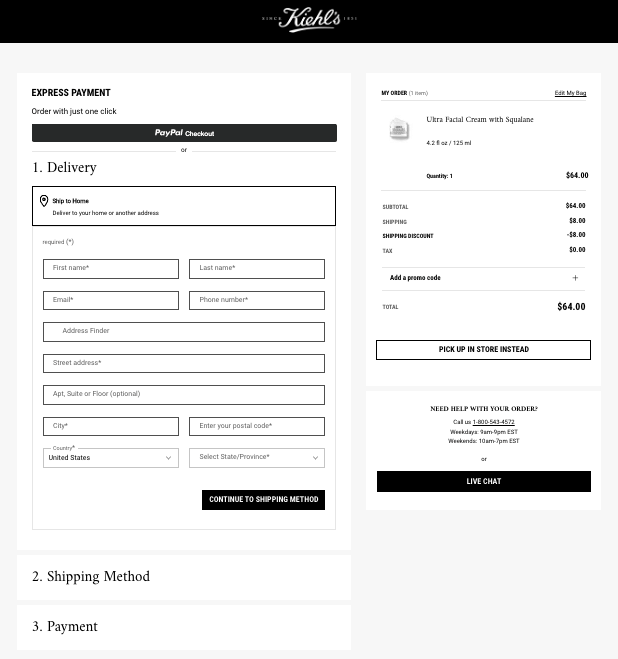 Kiehl’s checkout page
Kiehl’s checkout pageAnother option to motivate shoppers to finish the checkout process is to add a progress bar showing how close they are to completion. If users know they’re almost finished, they may be more likely to finish filling out those last few form fields.
Keep the order visible
Another way to motivate customers to reach the finish line is to keep their purchases visible throughout the checkout process. For instance, Kiehl’s checkout page displays the customer’s selections next to the form. Keeping the images of their chosen products visible makes the purchase more real, and the user remembers why they put the items in their cart in the first place.
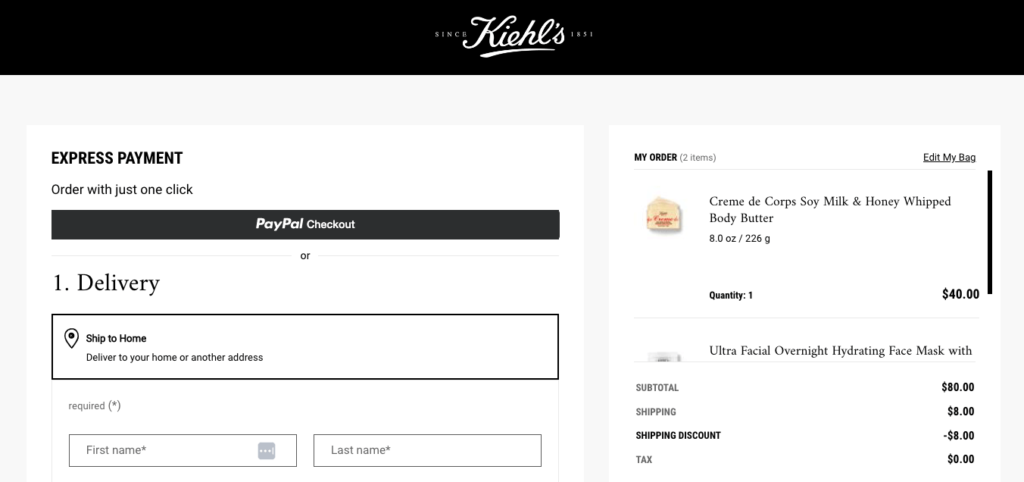 Kiehl’s Product Display at Checkout
Kiehl’s Product Display at CheckoutOffer guest checkout
Considering that forced account creation is the second-most-cited reason for cart abandonment, allowing customers to check out as guests (in other words, without creating an account) could be a simple way to boost your order completion rate.
But whether to allow guest checkout is a judgment call that depends on what value mandatory accounts have for your business. It’s important to note that, with guest checkout, you can only send the customer transactional emails related to their order, not promotional emails.
Understand the impact of your abandoned carts with our FREE cart abandonment revenue calculator!
Diversify payment options
While too few payment options wasn’t a top reason for shopping cart abandonment (cited by 9%), it’s still a significant factor for some of your audience. The diversity of payment methods should be an important factor in selecting your ecommerce platform or payment processor.
Ban.do, an ecommerce site that offers apparel, decor, and stationery gives shoppers a wide range of payment options, including Google Pay and Meta Pay.
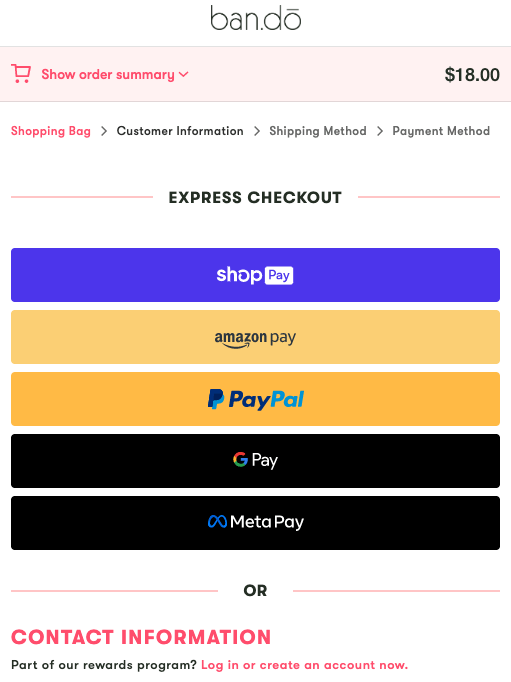 ban.do checkout page payment options
ban.do checkout page payment optionsMulti-payment solutions, like Afterpay, Klarna, and Affirm, are another way to influence customers to complete an order. Ban.do uses Afterpay, which allows shoppers to pay in 4 installments.
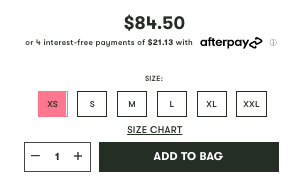 ban.do product page with Afterpay
ban.do product page with AfterpayTrust symbols
If you’re a small business, adding trust symbols from payment processors or your ecommerce platform is a subtle way to give customers peace of mind about the security of their purchase.
If the platform you use isn’t a well-known brand, trust symbols from recognizable platforms or services give customers a sense of security. You can also add security shields, certifications, and other markers of legitimacy.
Social proof
Social proof is another way to build trust and encourage shoppers to purchase. Many ecommerce sites incorporate user reviews but don’t be shy about highlighting glowing product reviews.
Unobtrusive notices of other customers’ purchases can influence shoppers. Vegan chocolate brand CHOMP! uses a tool called Nextsale to show users who are buying the products they’re browsing. This creates a sense of bustling business and scarcity.
 CHOMP! customer purchase popup
CHOMP! customer purchase popupExit intent popups
An exit intent popup is a message that appears when there are signals that the user intends to exit the page. It can be triggered by a shopper moving their cursor off your web page, scrolling upward, or pressing the “back” button.
Popups can be irritating and intrusive, so your message needs to be strategic. For example, if it seems a user is about to abandon their cart and leave your site, a popup with a discount code could be the little push they need to head to the checkout page.
Automate Your Abandoned Shopping Cart Emails
Recover sales with automated abandoned cart emails, starting with a 14-day free trial of ActiveCampaign.
While you can use the above strategies to reduce shopping cart abandonment, that won’t eliminate it. So how do you recoup business after a shopper abandons their cart?
Here are the top 3 ways to get customers to come back and complete their purchase:
1. Persistent shopping carts
There are many reasons someone might abandon their shopping cart when they still want to purchase. Sometimes, a shopper gets distracted. Other times, they may wait for their payday to make a purchase. Or maybe they don’t have their credit card on hand.
Persistent shopping carts allow users to purchase the products they picked out when they return to a site. Websites can use cookies to retain information about what a user has placed in their cart. Most often, this is set up in your ecommerce platform.
2. Retargeting
Retargeting ads are a great way to remind shoppers of the cart they left behind. Retargeting ads use browsing information from a shopper’s cookies to display ads for the products they were browsing. For example, if you placed a new jacket in your shopping cart but then left the site, your next search engine results page might have an ad for jackets from the site you were browsing.
You can also use retargeting to send email promotions and offers to customers. ActiveCampaign makes it easy to segment your email contacts and use behavioral information to send them the most relevant content in your retargeting emails.
3. Abandoned cart emails
Shopping cart abandonment emails are widely used to get customers’ attention when they leave a potential purchase behind. Here, behavior tracking determines when a known contact abandons a purchase, which triggers an email reminding the customer to complete the transaction. Brands often include coupon codes to give customers a little extra motivation.
Abandoned cart emails can be extremely effective. Desmistificando, a business that provides professional training for the legal industry, used ActiveCampaign’s automation workflows to win back a full 50% of their abandoned purchases. You can start consistently recovering abandoned purchases with simple automations and only a little time and effort.
Here we’ll cover some of the most common questions people have about shopping cart abandonment.
Why is shopping cart abandonment a problem for retailers?
Every abandoned shopping cart is a lost sale. That amounts to an estimated $18 billion that ecommerce businesses are missing out on. Beyond lost sales, tracking and analyzing shopping cart abandonment allows businesses to learn about their customers and online purchase processes.
What is the average shopping cart abandonment rate?
There are a lot of numbers floating around, most of which are between 60% and 80%. The Baymard Institute calculated an average of 48 different rates that came out to 69.99%
How can we avoid abandoned carts?
Generally, businesses can reduce their shopping cart abandonment rate by creating a simpler, faster, and more transparent checkout experience. Because shoppers cite fees and shipping costs as the number 1 reason they abandon a purchase, free or more transparent shipping is a key strategy for increasing checkout completion. Adding trust symbols, social proof, and various payment options is also helpful.
No matter what kinds of products you sell online, shopping cart abandonment can hugely impact your revenue. While distractions will always pull customers away, businesses should focus on what they can control: the buying process.
Some carts will inevitably be abandoned, but you also have tools to win back those customers, like email and nurture campaigns.
To find out how you can create a better customer experience, start your free trial of ActiveCampaign.

